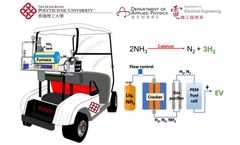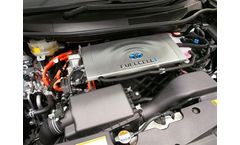PEMFC fuel cell Articles
-
Nanoporous Pt
n+–CeOxcatalyst films grown on carbon substratesDeposition of the Pt doped cerium oxide catalyst layers on carbon nanotubes and flat carbon substrates by magnetron sputtering leads to growth of solid solution films composed of nanorods oriented perpendicularly to the substrate surface forming fractal like highly porous structure. The films contain only cationic Pt2+ and Pt4+. Cerium oxide is partially reduced. The catalyst films reveal high ...
-
Corrosion and contact resistance measurements of different bipolar plate material for Polymer Electrolyte Membrane Fuel Cells
Different types of commercial stainless steels (SS316, SS310 and incoloy 800), poco graphite, composite graphite, titanium carbide, zirconium carbide and carbide base coating on aluminum substrate using thermal spray technique were evaluated as metallic bipolar plate in terms of Interfacial Contact Resistance (ICR) and corrosion resistance in a solution simulating the environment of a bipolar ...
-
An Ammonia-powered Fuel Cell Electric Golf Cart System
Ammonia (NH3) is a carbon-free hydrogen (H2) carrier, which enables liquid-phase H2 storage and transport under mild conditions. Although the concept of NH3-to-H2 has been frequently proposed, the practical application of NH3 as the energy source for H2 power automotive systems is rarely reported. To close the gap between NH3 supply and H2 utilization, we demonstrated an NH3-powered fuel ...
-
A PEM fuel cell temperature controller design using a thermal equivalent circuit model
In order to control a temperature in the fuel cell system, a thermal equivalent circuit model for PEM fuel cells and its control algorithms are presented. By defining temperature as a state, the energy balance model can be established so that feedback control algorithm can be directly employed. The details of the design of the thermal equivalent circuit model and its control scheme are provided ...
-
Effect of various micro-porous layer preparation methods on the performance of a proton exchange membrane fuel cell
Proton exchange membrane fuel cells (PEMFCs) have been widely studied and discussed in the field of energy owing to their high energy efficiency and low waste emissions. A PEMFC uses hydrogen gas as a fuel, and works by causing hydrogen ions to link up with oxygen, producing liquid water as its sole by-product. The design of a PEMFC's micro-porous layer (MPL) can not only enhance cell ...
-
Engineering models for fuel cell production management
Membrane electrode assemblies are the key components of proton exchange membrane fuel cells. The future demand for this product could grow exponentially if key technical challenges are successfully addressed including low cost mass production and reliable customer order fulfilment. This study reports on a multidisciplinary team effort to formulate and apply engineering models for managing the ...
-
Effects of some micro-level exergetic parameters of a PEMFC on the environment and sustainability
This paper deals with studying the effects of some micro-level exergetic parameters of a Polymer Electrolyte Membrane Fuel Cell (PEMFC) on macro-level environmental pollution and sustainability. For this purpose, various exergetic, environmental and sustainability parameters of a PEMFC are investigated based on its operating and technical conditions. Consequently, these parameters may be utilised ...
-
Thermodynamic modelling of a proton exchange membrane fuel cell
This paper presents the thermodynamic modelling of a proton exchange membrane (PEM) fuel cell at various operating conditions through energy and exergy analyses. In addition, the correlations and equations available in literature were used to determine thermodynamic irreversibilities in the PEM fuel cell at different operating conditions such as cell temperature, pressures of anode and cathode, ...
-
Carbon Nanotubes and Nanohorn Hybrid Composite Buckypaper as Microporous Layer for Proton Exchange Membrane Fuel Cell
Abstract In the present work, carbon nanotubes (CNT) and CNT-carbon nanohorns (CNH) (0, 30, 50, 70 and 100 wt.% CNH) composite Buckypapers (BPs) were fabricated using vacuum filtration technique. Structure and property relation of composite BPs were studied using scanning electron microscope, four probe technique, BET surface area and contact angle measurements. Properties such as electrical ...
By SusChem
-
In-situ investigation of the cathode catalysts for PEM fuel cells using differential electrochemical mass spectrometry
Differential electrochemical mass spectrometry (DEMS) involves applying a potential across an electrochemical cell and measuring the resulting current while concurrently analyzing gas products with a mass spectrometer. We used DEMS to investigate the mechanism of carbon support corrosion (CSC) in-situ at the cathode of proton exchange membrane fuel cell (PEMFC). The cathode exhaust gases were ...
-
What is the Purpose of a Gas Diffusion Layer (GDL)?
The Gas Diffusion Layer (GDL) plays several critical roles in a typical fuel cell application and is often integrated as part of the Membrane Electrode Assembly (MEA). Typical applications that use GDLs consist of Polymer Electrolyte Fuel Cells (PEMFC) and Direct Methanol Fuel Cells (DMFC). When a GDL is coated with a catalyst it is than referred to as a Gas Diffusion Electrode (GDE), which are ...
-
South Africa`s fuel cell plan risks failure without support
An ambitious strategy to create fuel cell products for export will need incentives and cross-government backing to bear fruit, says Radhika Perrot. South Africa's Department of Science & Technology (DST) has been laboriously pushing for the development of hydrogen fuel-cell technology through an ambitious research and development (R&D) strategy since 2005. Fuel cells can convert the ...
By SciDev.Net
-
A Finite Element Method analysis and optimisation of a polymer electrolyte membrane fuel cell with interdigitated flow field design
Interdigitated polymer electrolyte fuel cells are particularly attractive due to the enhanced transport rates and benefits with respect to electrode flooding. A 2D isothermal model is used to simulate the outlining processes that occur at the elemental fuel cell level. A Finite Element Method analysis is conducted to simulate the flow and current density fields for different gas channel ...
-
Using TGA-MS to Explore Novel Hydrogen Carriers for Fuel Cells
Hydrogen (H2) production is pivotal in the global shift towards a net-zero carbon economy. Its elemental abundance and zero-emission combustion position it as an ideal renewable energy source. However, the journey to harness hydrogen’s full potential is fraught with challenges, particularly in storage and transportation. Researching viable hydrogen carriers is critical, as conventional ...
Need help finding the right suppliers? Try XPRT Sourcing. Let the XPRTs do the work for you

